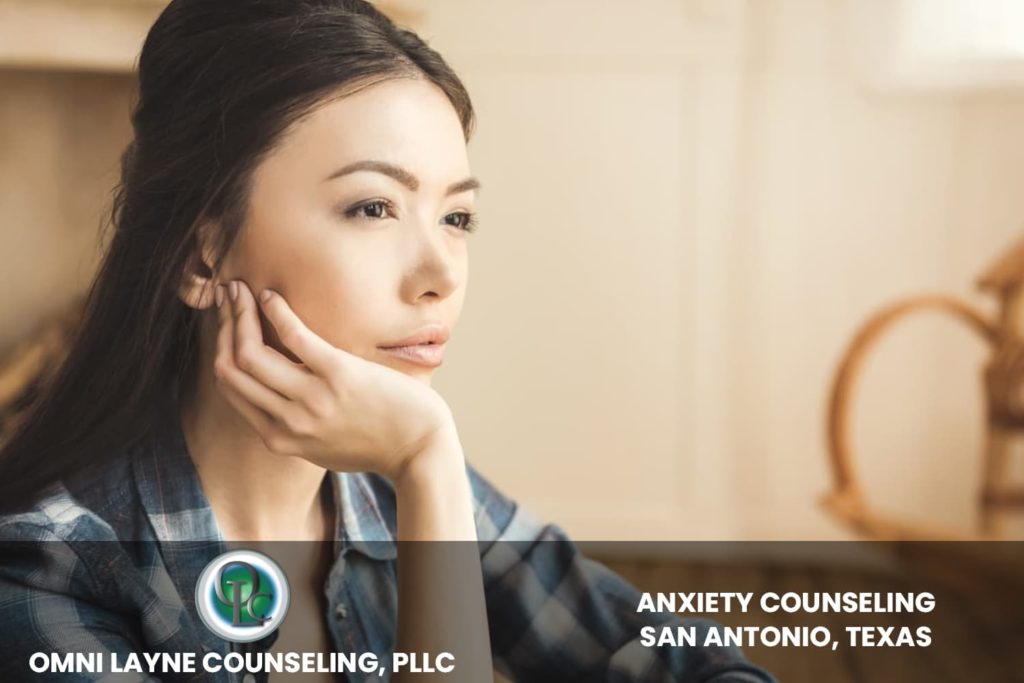Anxiety Counseling
with Omni Layne Counseling, PLLC
3740 Colony Dr #122, San Antonio, TX 78230, United States
Located in Colonies North Professional BLD

Anxiety is a mental and bodily state of anticipating the worst. It is characterized mentally by elevated alertness and trepidation twisted into excruciating worry, and physically by uncomfortable activation of many body systems—all to facilitate response to an unknown danger, real or imagined.
The cognitive thoughts of dread in expectation of a terrible outcome, as well as physical symptoms like jitteriness and a racing heart, are intended to cause discomfort. Anxiety is designed to draw your attention and motivate you to make the necessary changes to defend what you value. Anxiety is normal and can even be beneficial on occasion. Anxiety might be thought of as the price we humans pay for being able to imagine the future.
Anxiety disorders are characterized by chronic, pervasive, or exaggerated anxiety that disrupts daily life, whether at school, work, or with friends. Almost one-third of adults in the United States will experience uncontrollable anxiety at some point in their lives.
Anxiety is frequently associated with depression, and the two share many symptoms as well as many of the same brain circuits. Biology, as well as developmental experiences such as early trauma and parenting tactics such as overprotection, can all contribute to anxiety vulnerability.
It is neither possible nor desirable to completely eradicate worry, as it performs an important role in keeping us attentive and alive. The treatment is designed to keep anxiety under control. Anxiety can be successfully managed with counseling, medication, or both. Lifestyle changes, such as frequent exercise and deep breathing, are also crucial in anxiety management.
Anxiety is now the leading mental health problem around the world, and the incidence of anxiety is still rising, especially among youth. Increasing numbers of children and adolescents are being diagnosed with the disorder.
One often-cited reason for the general rise in anxiety is the burden of uncertainty in almost every domain of modern life, in response to an array of economic and cultural shifts. Uncertainty doesn’t cause anxiety, but it provides breeding grounds for it.
Two important factors contributing to anxiety among the young are parenting practices that overprotect children and the rise of social media. Technology provides new opportunities for connecting people, but it also leads to new experiences of negative social comparison and new pathways for social exclusion.
Anxiety manifests itself not just through unending loops of concern in the mind, but also through heart-pounding discomfort in the body, ranging from general shaking and jumpiness to ringing in the ears and shortness of breath.
Anxiety signs in the body can be extremely deceptive. Not only are they frequently misunderstood as indicators of a heart attack and imminent doom—a hallmark of panic attacks—but they also frequently lead to medical misdiagnosis odysseys. Physical symptoms may be considered to be the result of physical reasons, and the underlying source of the problem may go unnoticed and unaddressed as a result of a misdirected search for them.
Panic attacks are sudden bursts of intense worry that can make you feel as if you’re about to die—but they’re not. Anxiety-related physical sensations become exceedingly intense—pounding heart, racing pulse, difficulty breathing—and cause even more anxiety, exacerbating the panic.
Panic attacks can develop unexpectedly, even while sleeping, and the sense of loss of control heightens the panic. Even though such attacks appear to be dreadful and overwhelming, they can be stopped—even while they are taking place.
One in every eight children may suffer from significant anxiety. Their initial concern is being away from their parents. However, they are concerned about a variety of issues, ranging from uncontrollable fires and natural disasters to conflicts between their parents that may result in divorce. They are also concerned about the greater globe, which includes terrorism and the effects of climate change.
Normal fears become serious when they interfere with sleeping, going to school or paying attention in school, or participating in group activities. The growth of helicopter parenting is one key factor increasing the prevalence of childhood anxiety.
Anxiety disorders are frequently successfully treated with psychotherapy, either alone or in conjunction with medication, as well as lifestyle changes. One of the most effective approaches is cognitive behavioral therapy (CBT), which is tailored to an individual’s specific worries. Patients learn to resist the faulty mental patterns that cause them so much pain.
Most behavioral treatments for anxiety include exposure therapy, in which patients are safely and gradually exposed to their concerns until they no longer avoid them. Medication is frequently used to help patients regulate their symptoms so that they can focus on talk therapy.
Changes in lifestyle play a significant part in the long-term management of anxiety. Exercising, deep breathing, and meditation programs all target distinct aspects of the condition.
Cognitive behavioral therapy is the first-line treatment for anxiety. Therapy, which is both practical and present-oriented, assists people in recognizing the cognitive distortions that anxiety imposes on them, assisting them in confronting their concerns safely, and providing tools for reversing reactivity.
The purpose of treatment, like any other, is to restore calm. But it does a lot more than that. It assists people in regaining control of their lives when concern threatens to overwhelm them.
The extra benefit of therapy is that it takes place in the presence of a genuine human being. We have nerve systems that are extremely sensitive to the influence of others since we are social creatures. The presence of a helpful person sends a strong signal of safety, directly and deeply counteracting the (misguided) alarms of threat that characterize anxiety disorder.
Anxiety is completely normal and one of the inescapable expenses of being—and staying—alive. However, fears can spiral out of hand at times.
They may appear for no apparent reason, be disproportionate to the circumstance, or persist beyond attempts to fix any plausible problem. Alternatively, your anxiety or bodily symptoms may urge you to avoid circumstances that may cause discomfort. When anxiety absorbs too much mental activity or interferes with activities and performance, it becomes a disorder.
Anxiety manifests itself in several diagnostically unique ways. Generalized anxiety disorder, in which worries about any of life’s key domains—work, love, money, or health—is most common in older persons. The prevalence of Social Anxiety Disorder, which is more specifically focused on the dread of negative assessment by others, is increasing among young adults.
Phobias are typically associated with specific things or situations. Anxiety can come onto the scene in a sudden, strong burst and quickly rise to a terrifying crescendo. Panic episodes can appear seemingly at random, or they might recur with incapacitating frequency. Anxiety, in all of its manifestations, is treatable.
Being human with the ability to imagine a future is the true source of anxiety. It thrives on uncertainty, and there is a lot of ambiguity in the globe these days.
Anxiety is unique in that it can be triggered by external events—an upcoming doctor’s appointment, a marital quarrel, or a rent increase—or it can be generated entirely inside, through thoughts of real or imagined threats (not knowing what to say when the boss calls on you in a meeting).
Anyone can suffer from incapacitating anxiety. However, some people appear to be predisposed to anxiety: they view neutral situations as threatening or overreact to harmful situations due to heredity or temperament, potentially as a result of early experience, possibly due to over- or under-activity of some area of the brain.
Anxiety is exacerbated by stress, and the two illnesses overlap in many ways. Anxiety can both cause and be a result of stress.
Anxiety demands active therapy; else, it limits one’s life and tends to become chronic. However, this does not necessitate a prescription or medical intervention. Changes in lifestyle or behavior are some of the most effective strategies to decrease anxiety.
Meditation is an Eastern method that is gaining popularity in Western cultures for calming the mind. Running or walking on a regular basis helps to relieve the muscle tension that causes so much pain. It also has an effect on the brain. Deep (also known as diaphragmatic) breathing may be one of the most effective measures of all. It has a direct influence on the nervous system, generating calm and reducing sensations of danger.
What is the next step?
If you or someone you love is considering individual therapy or counseling, please contact Omni Layne Counseling. We are a team of professionals who have expertise to help.
Call us at our office to schedule an appointment with one of our highly skilled clinicians at Omni Layne Counseling, PLLC.
